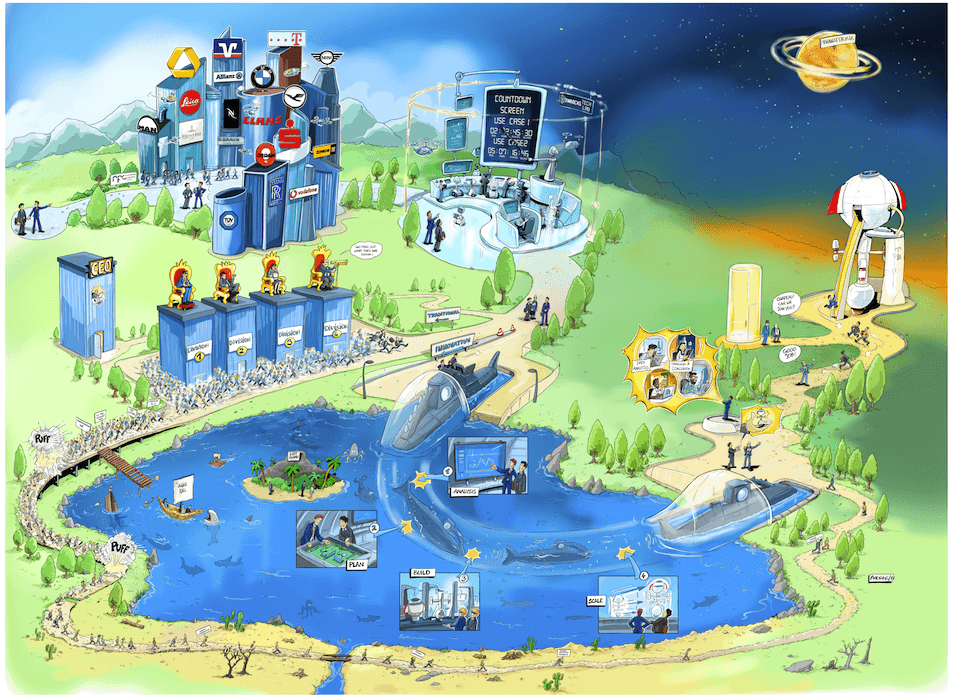
Minimum Viable Product – the customer centric way to fast innovation
Everyone is talking about innovation. But apart from “best in class” players like Google, Amazon & Co, it is hard to find companies, that really “crack the nut” and make innovation a building block of their DNA by implementing ideas smoothly, fast, continuously and in a profitable way. Developing innovation and new solutions has never been more important to respond to customer needs and expectations – nevertheless companies still struggle with it.
Innovation in the financial industry
Let’s have a closer look at the financial industry. Here is what we at rpc normally experience when traditional companies want to push innovation:
- An executive has an idea and a budget of some sort to implement it. The idea goes through long alignment cycles and any potentially involved stakeholder needs to be aligned before the idea is pushed to the project team
- The project team kicks off the project with a “more than comprehensive” analysis phase. On average, three months pass by
- This analysis phase is all about alignments, IT implications for systems and architecture, compliance checks, and even more alignments
- Upfront definition of the fully fledged solution down to minute details and drafting of the “untouchable project plan”. What else? Yes, some more additional alignments
After this last phase, the team starts the development of the fully fledged solution. Depending on the scale of the project, the end result can be delivered within six to nine months to up to two years.
Why does this typical approach not really suit innovation projects?
1. Executives’ tastes might differ from customers’ tastes: Top/down ideas are not always customer-centric, meaning that innovative solutions will not necessarily be loved by customers just because some executive in his/her ivory tower loves it as his/her baby. History tells us that in most cases, the key reasons for new innovative products failing have their roots in a lack of consideration of the genuine customer preferences
2. Three months of analysis nowadays means a lifetime: A timeframe of two to three months for carrying out an analysis is simply too long. While you are still doing your analysis, some competitors will definitely already be developing exactly your idea and will even enrich it with additional cool features. By losing so much time, your innovative idea will be outdated even before the start of development
3. Alignments kill ideas: Even though it is crucial to take care of compliance topics and bring the organization on board, alignments should not become an impediment to innovating. Companies in the finance industry are often a prime example of the silo mentality and resistance to change. So, the overarching question to be asked is: Who really needs to be brought on board and who will simply slow us down and try to change the idea to fit their own hidden agenda and goals?
4. How do you know today what the future product should look like? What is the benefit of spending months aligning each and every minor detail of a solution that will perhaps be used in two years’ time? Who knows what this solution should look like in two years’ time? Innovation is often about new concepts and ideas that can be difficult to grasp and fully understand to start with, let alone having a complete picture of the final outcome. The finance industry is currently being disrupted at an unprecedented pace, so setting details in stone today means rolling out products and solutions that are already outdated by the time they are put on the market. Receiving continuous feedback from the market, from customers and even from competitors is essential in order to ensure sustainable and successful innovation
How do we at rpc respond to these dilemmas?
1. Create and validate the idea with customers and stakeholders. This does not sound very fancy, but It is vital to check whether innovative ideas are at all appealing to customers before investing time and money in developing anything
2. Carry out the analysis quickly, then start to develop immediately. Analysis is a fundamental step in order to create new ideas in a sustainable way, but for innovations it is sometimes more important not to lose traction and time. So, starting an agile development as soon as possible is key
3. Align with only the most relevant stakeholders: Try to get only the people who play a role for the project’s success on board, bypass all the silos of typical finance industry firms and all unnecessary rounds of alignments
4. Be agile in the development and produce something you can test and learn from as quickly as possible. Why build an entire department store when you can start with a functioning cool shop and see whether customers come by at all and buy things? One common mistake that banks and insurance companies make is not accepting the fact that it is okay to put solutions on the market that are not the fully fledged final product. Being fast in piloting ideas means learning faster and being even faster in modifying your concept as needed in order to reach the goal
We at rpc often work on innovation projects in the financial industry with the Minimum Viable Product (MVP) approach. An MVP is a development technique in which a new product or website is developed with sufficient features to be tested on a market, meet customer needs and still satisfy those customers who will adopt your solution from day one. The final, complete set of features of the innovative product is only designed and developed upon product success and after considering feedback from the product’s initial users.
The pillars of the MVP approach are:
- Make sure that your idea is customer-centric and validate the customer’s appetite before getting started
- Prototype in accordance with customer needs
- Test and learn fast
- Improve iteratively
One firm that notoriously made use of the MVP approach and took it to the next level is Dropbox. At the beginning, they pretended they had their product up and running already and created an explainer video, whereas in reality they had not yet written a single line of code.
Before investing any money in building an infrastructure, developing apps and so on, the Dropbox founders wanted to check if their file-syncing idea would appeal to their end customers at all. They pushed the explainer video with a minimum marketing budget and, overnight, they generated more than 70k views of their website from prospect customers, who, despite not finding any product to test, gave their e-mail address in order to be updated on future developments. Validation of innovation before any real investment. Clever – you know what I mean?
Our recently built financial services line headed by Patrick Pfalzgraf offers a 360 degrees consulting approach for banks, insurance companies and German health insurance companies. We leverage the existing rpc portfolio and enrich it with even more innovative and technology-oriented topics such as MVP Development, Rapid Prototyping, Blockchain technology and much more. Curious? Connect with us to find out more!
contact our financial industry partner

Patrick Pfalzgraf
PartnerPatrick Pfalzgraf heads the Financial Industry division at rpc. He is a proven industry expert for financial industries with a focus on digital transformation, strategy, sales performance and operational excellence.
how health insurers can path the way to true customer orientation
Read more...empowering software users with WalkMe
Read more...increasing sales performance in the financial industry
Read more...





